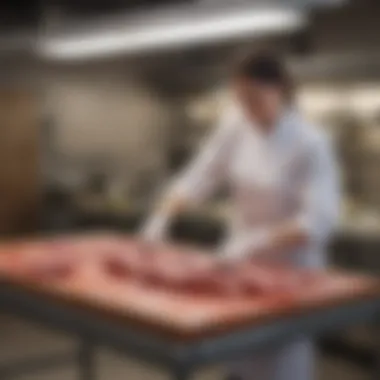A Deep Dive into Butchering Tables: History and Innovation


Intro
The exploration of butchering tables holds significance across various domains, including culinary arts, food processing, and even agriculture. While they may seem like simple work surfaces, butchering tables embody a rich history and serve multiple modern functions. Their design and functionality have evolved with changing practices, technologies, and concerns for hygiene and ergonomics. This article intends to dissect these elements systematically, offering insights into the intricate designs, historical contexts, and innovations that characterize butchering tables today.
Key Concepts and Terminology
Definition of Key Terms
Understanding butchering tables requires familiarity with several specific terms:
- Butchering Table: A sturdy work surface designed for cutting meat and processing animal products.
- Ergonomics: The study of people's efficiency in their working environment, focusing on designing workspaces that reduce strain and increase comfort.
- Material Composition: The types of materials (wood, metal, and plastic, for instance) used in constructing butchering tables, each offering distinct advantages and disadvantages.
Concepts Explored in the Article
This discussion covers several key concepts:
- Historical significance of butchering tables, tracing their evolution from traditional methods to modern practices.
- Material choices and why they matter, considering aspects like durability, sanitation, and ease of maintenance.
- Ergonomic considerations that enhance user comfort and efficiency during the butchering process.
- Technological advancements that have introduced new designs and features in butchering tables.
- Sustainability issues related to material sourcing and product lifecycle.
Findings and Discussion
Main Findings
Our exploration reveals several noteworthy findings:
- Historical practices heavily influenced the current design and functionality of butchering tables. Traditional wooden tables offer historical context, while modern tables may use stainless steel or composite materials for improved hygiene.
- Ergonomic features are becoming increasingly important, as more professionals recognize the physical demands of butchering. Designs that promote proper posture lead to fewer injuries and increased productivity.
- Advances in technology have led to innovative designs that include features like integrated sinks or storage spaces, catering to the needs of modern culinary environments.
Potential Areas for Future Research
Future inquiries can expand on the following areas:
- Further investigation into the long-term effects of different materials on usability and sanitation.
- Examination of how advancements in technology will continue to shape the future of butchering tables.
- A deeper look into the experiences of butchers concerning ergonomic challenges and solutions.
This examination of butchering tables is not merely about a work surface; rather, it is an integral component of culinary practices that deserves comprehensive study and appreciation.
Preamble to Butchering Tables
Butchering tables serve as a foundational element in the culinary world, especially within meat preparation and processing. Understanding their significance allows one to appreciate not only the craftsmanship involved but also the various operational roles they play in kitchens, butcher shops, and processing facilities. The design and use of these tables impact not only efficiency but also safety and hygiene, which are crucial in today’s food industry.
Definition and Purpose
A butchering table is essentially a sturdy work surface where the preparation and cutting of meat occurs. Its structure is specifically engineered to withstand heavy impacts, resist damage from knives, and ensure stability during use. The purpose of these tables extends beyond mere utility; they embody principles of ergonomics and hygiene that are vital to the processes of meat handling. Properly designed, a butchering table can facilitate an efficient workflow, reducing the physical strain on workers and allowing for greater precision in cutting tasks.
The choice of materials and design can also influence the flavor and quality of the meat, as certain surfaces may harbor bacteria more than others. Thus, the table not only serves a functional role but also plays a part in ensuring the quality of the final product. Overall, understanding the definition and purpose of butchering tables is crucial for professionals and enthusiasts alike who wish to maintain high standards in their culinary practices.
Historical Context
The tradition of butchering dates back thousands of years. Historically, butchering tables were often rudimentary, made from available materials such as wood. Early societies utilized these tables for communal meat preparation, which played a significant role in their food culture and social structure. In small villages and communities, butchers often worked in open areas, displaying their skills while engaging with the customers.
As society evolved, so did the methods and tools related to butchering. The introduction of stainless steel marked a significant advancement in hygiene standards, changing the landscape of food preparation. These innovations allowed for better cleanliness and durability, aligning with growing public health concerns over time. Today, the historical evolution of butchering tables reflects broader changes in technological, economic, and social contexts. Recognizing this history helps inform current practices and highlights the ongoing importance of proper butchering techniques.
Key Design Features of Butchering Tables
Understanding the design features of butchering tables is critical. These tables play an essential role in the butchering process. When considering a butchering table, factors such as material, dimensions, and hygiene should be prioritized. The design can directly impact the efficiency, safety, and overall effectiveness of butchering practices. This section will elaborate on these vital aspects.
Material Considerations


Wood vs. Stainless Steel
The choice of material significantly affects the durability and usability of butchering tables. Wood offers a traditional appeal and has natural antimicrobial properties, making it a preferred choice among some butchers. However, stainless steel presents a more modern alternative. Its smooth surface resists bacteria and is easier to clean. This characteristic makes stainless steel a beneficial choice in environments that require strict hygiene standards.
The key characteristic of stainless steel is its resistance to corrosion and staining. This feature enhances its longevity, especially in commercial settings where high volume usage occurs. On the other hand, wood can be more susceptible to damage from water and certain chemicals.
Plastic Options
Plastic options provide an alternative that cannot be overlooked. These tables are lightweight, which is a considerable advantage for mobility. The non-porous nature of plastic aids in hygiene, as it does not absorb juices and is easily sanitized. The key characteristic here is their convenience and lower cost compared to other materials. They often come in various colors, allowing for easy color-coding to avoid cross-contamination.
While plastic tables are beneficial, they may not have the same sturdiness as wood or stainless steel. They are prone to cuts and scratches, which can harbor bacteria if not maintained properly.
Dimensions and Ergonomics
Height Standards
Height standards are an important factor in the design of butchering tables. The key characteristic of an appropriately sized table is to ensure ergonomic working conditions. A table that is too high or too low can lead to discomfort and fatigue for the butcher. Height-adjustable tables are becoming more popular as they accommodate various user preferences.
The unique feature of established height standards relates to the ability to maintain posture during work. This design consideration reduces strain on the back and neck.
Surface Area
The surface area of a butchering table influences the amount of workspace available. A larger surface allows for more efficient workflow, especially in commercial applications where multiple tasks are performed simultaneously. Moreover, a sizable area can help in reducing the risk of cross-contamination, as it allows for better organization of different meat types.
The unique feature here is the capability of optimizing space usage, which can be a defining advantage during high-demand periods. Insufficient surface area can lead to unsafe practices, compromising hygiene and efficiency.
Hygiene and Maintenance
Cleaning Protocols
Implementing effective cleaning protocols is essential for butchering tables. Cleanliness in such environments is paramount for food safety. The key characteristic of a good cleaning protocol is its efficiency. Regular cleaning reduces the accumulation of bacteria and ensures that the work environment is safe. Specific guidelines must be established and followed diligently.
A unique feature of cleaning protocols involves the use of appropriate disinfectants that are effective yet safe for food preparation surfaces. Maintaining these protocols is often an ongoing challenge that requires commitment from team members.
Sanitation Best Practices
Sanitation best practices extend beyond surface cleaning; they encompass the entire workspace. The key characteristic of these practices is the focus on prevention of contamination. This includes training personnel on proper handling techniques and the importance of personal hygiene.
The unique feature of comprehensive sanitation practices includes regular inspections and monitoring of compliance. This aspect is critical in both commercial and artisanal scenarios. Non-adherence can lead to serious hygiene violations, potentially affecting business reputation and public safety.
Maintaining a high standard of cleanliness is not just a regulatory obligation; it is a critical component of achieving excellence in butchering practices.
Applications of Butchering Tables
Butchering tables serve critical roles in various settings where meat processing occurs. Consumers, chefs, and farmers rely on these tables for their distinct applications. Understanding these applications can enlighten the reader on the significance and utility of butchering tables in diverse contexts.
Commercial Use
Meat Processing Plants
Meat processing plants represent a significant application of butchering tables. These facilities handle substantial quantities of meat daily, making efficiency and hygiene paramount. The primary design of meat processing tables considers durability and cleaning ease. The materials used, which often include stainless steel, are resistant to corrosion and easy to sanitize. This characteristic ensures that the tables can be maintained in compliance with health regulations.
A unique feature of these tables is their large surface area, which allows for multiple butchers to work simultaneously. This leads to increased productivity and more effective use of time. Moreover, the ergonomic design of these tables minimizes physical strain on workers, which is essential in high-volume operations.
Despite their benefits, these tables do require rigorous cleaning protocols, as any lapse can lead to contamination issues. This challenge makes training on hygiene practices vital for people working in meat processing plants. Such diligence is crucial to maintaining food safety standards.


Restaurants and Catering Services
In restaurants and catering services, butchering tables are integral to the meat preparation process. They are used for cutting, trimming, and portioning meat for various dishes. The presence of dedicated butchering stations enhances efficiency in kitchen operations. Its arrangement can also be tailored to the specific needs of chef teams.
A key characteristic of restaurant butchering tables is their size; they are designed to fit within often limited kitchen spaces while still providing ample work area. This consideration is essential for balancing productivity and space usability. Some restaurants opt for mobile tables, which can be moved and stored to optimize kitchen workflow.
The unique aspect of these tables is their versatility. Besides meat, they can be used for different food preparation tasks, which adds value to restaurant operations. However, this dual use can raise hygiene concerns, as proper sanitization becomes even more crucial. Chefs and staff must consistently follow sanitation best practices to mitigate any risk.
Artisanal Butchering
Farm-to-Table Practices
Farm-to-table practices have gained popularity in recent years, changing how meat is sourced and processed. This approach emphasizes the importance of local sourcing of meat, using butchering tables as a critical link in the supply chain. Butchering tables used in this context often reflect a commitment to quality and sustainability.
The key characteristic of farm-to-table practices is their focus on transparency and traceability. Consumers are increasingly concerned about where their food comes from, and local butcher shops utilizing quality butchering tables can provide that reassurance. This aspect enhances customer trust and satisfaction.
Moreover, the unique feature here is the relationship between farmers and butchers. This collaboration often leads to fresher, higher-quality meat. However, challenges persist, such as sourcing adequate volumes at various times of the year. Seasonal variability can impact supply stability, which must be managed carefully.
Local Butcher Shops
Local butcher shops play a vital role in communities by combining traditional skills with modern standards. The butchering tables used in these shops allow artisans to execute their craft while maintaining quality control. These tables are usually crafted from long-lasting materials that stand the test of time.
The key characteristic of local butcher shops is their personalized service. Butchers often engage with customers directly, providing recommendations and customizing cuts according to preferences. This service adds a personal touch that larger operations frequently lack.
A stand-out feature of local butcher shops is their focus on local sourcing, which supports community farmers. However, high operational costs and competition from larger chains can pose challenges. Butchers must find effective marketing strategies to attract and retain customers without sacrificing quality.
"The butchering table is not just a tool; it symbolizes the connection between food, community, and craftsmanship."
Understanding these applications allows stakeholders in the meat industry to make informed decisions about their butchering practices. This knowledge can influence everything from table selection to workforce training, ultimately enhancing both the product quality and the customer dining experience.
Technological Innovations in Butchering
Technological innovations play a vital role in enhancing the efficiency, safety, and functionality of butchering tables. In an industry where precision and hygiene are paramount, these advancements are becoming essential tools for butchers and food processors alike. They provide solutions that streamline processes, address environmental concerns, and adapt to the evolving demands of the market.
Smart Butchering Tables
Integration of Sensors
Integration of sensors into butchering tables represents a significant step forward in food safety and quality control. These sensors can monitor temperature, humidity, and even contamination levels in real time. The primary benefit of incorporating sensors is the ability to maintain optimal conditions for meat preservation. This approach helps ensure compliance with health standards, minimizing the risk of spoilage or foodborne illnesses.
A key characteristic of sensor integration is its ability to automate certain tasks. For example, automated alerts can notify users when temperature thresholds are not met, potentially saving time and resources. However, one must also consider the maintenance of these systems. While sensor technology can enhance food safety, it may introduce complications if not regularly serviced or calibrated.
Data Management Systems
Data management systems are increasingly becoming integral to modern butchering practices, especially in larger operations. These systems facilitate the tracking of meat products from source to table, optimizing inventory management and improving traceability. The importance of data management in this context cannot be overstated; effective systems help ensure regulatory compliance and consumer trust by providing transparency throughout the food supply chain.
A fundamental characteristic of such systems is their ability to store large volumes of information, which allows for detailed analytics on meat production and sales. This data can assist businesses in forecasting demand and reducing waste. On the downside, the reliance on data management systems comes with a learning curve and potential vulnerabilities in cybersecurity that must be addressed.
Sustainability in Materials
Eco-Friendly Alternatives
As environmental concerns become more prominent, the shift towards eco-friendly materials in the production of butchering tables is gaining traction. These materials not only reduce environmental impact but also appeal to a growing segment of eco-conscious consumers. The use of sustainable woods and recycled plastics exemplifies this movement, as these options help lower the carbon footprint associated with traditional materials.
A noteworthy characteristic of eco-friendly alternatives is their variety, allowing for customization based on specific needs and preferences. Many of these materials come with certifications that validate their sustainability claims. While the introduction of green materials offers significant benefits, there may be trade-offs in terms of price and availability, which requires careful consideration.


Lifecycle Analysis
Lifecycle analysis is an important tool for assessing the environmental impact of butchering tables throughout their entire lifespan. This comprehensive approach examines materials sourcing, manufacturing processes, usage, and eventual disposal. By evaluating these stages, businesses can make informed decisions about the sustainability of their equipment.
The key characteristic of lifecycle analysis lies in its capacity to provide a holistic view of environmental impact. By understanding the full footprint of a product, operators can identify improvement opportunities and adopt best practices. However, implementing a thorough lifecycle analysis may require resources and expertise that not all businesses possess, potentially limiting its adoption.
In summary, technological innovations in butchering include smart tables with sensor integration and advanced data management systems. These advancements enhance efficiency and safety while sustainability efforts focus on eco-friendly materials and lifecycle analysis.
Challenges in Butchering Practices
The challenges faced in butchering practices encompass a range of critical factors that impact both the operational efficiency and the safety of the meat processing industry. A nuanced understanding of these challenges is essential as they can influence regulatory compliance, industry trends, and consumer preferences. Inadequacies in these areas can lead to serious repercussions, including health risks and economic losses. As the culinary landscape evolves, practitioners must navigate these complexities to provide quality products while adhering to requisite standards.
Regulatory Compliance
Health and Safety Standards
Health and safety standards form a fundamental aspect of butchering practices. These standards ensure that meat remains safe for consumption by minimizing health risks associated with foodborne illnesses. One key characteristic of these standards is the stringent guidelines for hygiene and sanitation prevalent across the industry. Following these health standards is a beneficial choice as it builds customer trust and promotes sustainability in the industry.
The unique feature of these standards lies in their comprehensive nature, addressing everything from the handling of meat to worker safety protocols. Their advantages include reducing liability and potential recalls, while disadvantages may include the costs and complexities involved in maintaining compliance.
Inspection Processes
Inspection processes play a vital role in maintaining the integrity of the meat supply chain. These processes involve regular audits and evaluations by regulatory bodies to ensure adherence to established health standards. The key characteristic of inspection processes is their ability to identify non-compliance swiftly, ensuring public health is not jeopardized. It is a popular choice for this article to highlight these processes due to their direct impact on safety and consumer confidence in products.
A unique feature of inspection processes is their systematic approach, where each step is documented and analyzed. The advantages of this thoroughness include increased accountability and traceability in meat sourcing. However, frequent inspections can also create administrative burdens for businesses, requiring allocation of resources to maintain compliance protocols.
Industry Trends
Impact of Veganism
The impact of veganism on butchering practices is significant and noteworthy. As consumer preferences shift, the demand for meat products faces scrutiny. The growing trend towards plant-based diets influences butchering operations in several ways, chiefly by forcing traditional practices to adapt or risk obsolescence. This impact encourages innovation and diversification in product offerings, allowing butchers to remain relevant in an evolving marketplace.
A key characteristic of this trend is the increasing awareness of ethical and environmental issues associated with meat consumption. This awareness positions veganism as not only a dietary choice but also a lifestyle that promotes sustainability. The unique feature of this movement compels the meat industry to pivot towards transparency and quality assurance, both advantageous in attracting a conscientious consumer base.
Changing Consumer Preferences
Changing consumer preferences drastically alter the landscape of butchering. Today's consumers seek transparency in sourcing and quality assurance, which necessitates adjustments in traditional butchering practices. This transition to informed consumerism highlights the importance of adaptability within the industry.
A prominent characteristic of these preferences is the prioritization of ethically sourced and organic meats. Such demands push butchering practices towards sustainability, ensuring humane treatment of livestock and minimal environmental impact. The unique feature of changing preferences is the influence of social media and information accessibility, which serves to educate consumers about their choices. The advantages include a broader market reach and loyal customer base, while disadvantages can manifest in increased operational costs and the need for continual adaptation to consumer demands.
In a rapidly evolving market, butchers must not only focus on quality of product but also embrace transparency and sustainability.
Ending and Future Directions
The topic of butchering tables is essential in understanding the broader spectrum of culinary practices and food processing. In this article, we have explored several crucial elements that shape their design and functionality. As butchering tables evolve, their integration of technology and ergonomics becomes more relevant. This evolution not only enhances efficiency but also impacts hygiene and safety standards significantly.
The benefits of advancing these tables include improving productivity in both commercial and artisanal settings. The exploration of materials further showcases the importance of sustainable practices in today's culinary landscape. Through proper design considerations, butchering tables can contribute to a safer workplace and a more environmentally friendly setup.
Future directions for butchering tables lie in pushing the boundaries of innovation. As industries adapt to changing consumer preferences and regulatory demands, there is a continuous need for research and development. New designs should prioritize features that accommodate the growing emphasis on sustainability while maintaining usability, ensuring that butchering practices align with modern standards.
"The integration of innovative technology can redefine traditional techniques while promoting sustainability in food processing."
Summary of Key Takeaways
- Historical Importance: Understanding the significance of butchering tables throughout history helps frame their current role.
- Design Considerations: Material choices, dimensions, and ergonomic features are fundamental to their effectiveness in various settings.
- Applications: Highlights the dual roles in commercial and artisanal environments, showing versatility and importance in the industry.
- Technological Innovations: Smart tables and eco-friendly materials are shaping the future of butchering practices.
- Challenges: Regulatory compliance and changing market trends necessitate adaptable designs and practices.
Research Gaps and Opportunities
Despite a comprehensive examination, there remain notable gaps in the research surrounding butchering tables. Areas worthy of exploration include:
- User Experience Studies: Research focused on how different butchering table designs impact user efficiency and comfort.
- Long-Term Sustainability: Investigating the lifecycle of materials used in butchering tables and their overall environmental impact.
- Technological Integration: More in-depth studies are needed on the effectiveness of smart butchering tables in real-world settings.
- Consumer Education: Understanding how consumer awareness about butchering practices affects market trends and product design.
Exploring these opportunities will not only fill existing knowledge gaps but also encourage innovations that benefit both producers and consumers in the culinary field.







